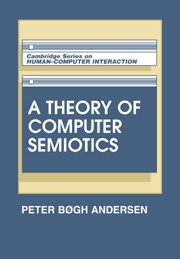 A Theory of Computer Semiotics
A Theory of Computer Semiotics Book contents
- Frontmatter
- Contents
- Preface to second edition
- PART I THEORY
- PART II COMPUTERS
- PART III LANGUAGE, WORK, AND DESIGN
- Introduction
- III.1 Language as interpretation. Semantic fields in the Postal Giro
- III.2 Language as action. Language games in the Postal Giro
- III.3 Task analysis. Controlling control.
- References
- Index
III.1 - Language as interpretation. Semantic fields in the Postal Giro
Published online by Cambridge University Press: 26 March 2010
- Frontmatter
- Contents
- Preface to second edition
- PART I THEORY
- PART II COMPUTERS
- PART III LANGUAGE, WORK, AND DESIGN
- Introduction
- III.1 Language as interpretation. Semantic fields in the Postal Giro
- III.2 Language as action. Language games in the Postal Giro
- III.3 Task analysis. Controlling control.
- References
- Index
Summary
Perspective differences at the Postal Giro
When we enter a large organization like the Postal Giro, we will be exposed to a large inhomogeneous mass of written and spoken language: we listen to the speech of workers engaged in work, interview them and talk to them, read manuals and look at the screen images they work with, and talk to management in offices removed from the shop floor. Although many of these verbal exchanges clearly refer to the same physical phenomena, the linguistic forms can be quite different. It soon appears that each linguistic form is adapted to the particular function the speaker fulfills in the total structure of work processes and power relations in the organization. Each sub-language expresses a particular perspective (on perspective, see Section 1.2.2.2) and reveals a partial truth about the organization.
In the development of the PGP system there was one major issue that in a nut-shell illustrates the intricate interplay between language, perspectives and position in the division of labor. In semiotic terms, the issue was simply the relation between signifier and signified, in this specific case taking the form of a disagreement between union and management about electronic scanning of paper forms.
Management wanted to get rid of all paper by optical scanning of the paying-in-forms and wanted all subsequent work involving the cards to be done by means of electronic card images on a video screen. The union demanded that the basis of data recording should still be the paper forms, so that a direct feeling of the amount of work remained intact. The union succeeded in preventing electronic scanning of paper forms.
- Type
- Chapter
- Information
- A Theory of Computer SemioticsSemiotic Approaches to Construction and Assessment of Computer Systems, pp. 341 - 370Publisher: Cambridge University PressPrint publication year: 1991


